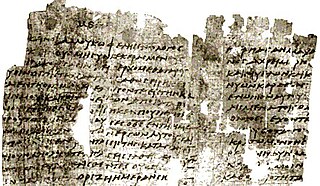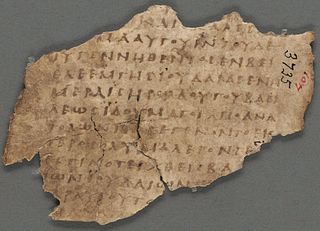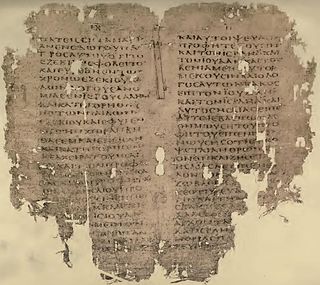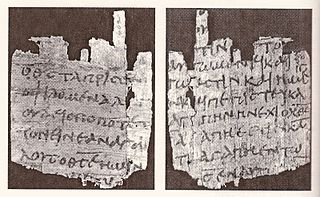| New Testament manuscript | |
| Name | P. Oxy. 848 |
|---|---|
| Text | Revelation 16:17-20 |
| Date | 5th century |
| Script | Greek |
| Found | Al-Bashnasa |
| Now at | University of Chicago Oriental Institute |
| Cite | B. P. Grenfell & A. S. Hunt, OP VI, p. 6. |
| Size | 12 x 8.5 cm |
| Type | Alexandrian text-type |
| Category | III |
| Note | concurs with codex A |
Uncial 0163 (in the Gregory-Aland numbering), is a Greek uncial manuscript of the New Testament, dated palaeographically to the 5th century.
The codex contains a small part of the Book of Revelation 16:17-20, on one parchment leaf (12 cm by 8.5 cm). It is written in one column per page, 17 lines per page, in small uncial letters. [1]
The Greek text of this codex is a representative of the Alexandrian text-type. Aland placed it in Category III. [1] The surviving fragment of text concurs with Codex Alexandrinus. [2]
Currently it is dated by the INTF to the 5th century. [1] [3]
The manuscript was found in Al-Bashnasa.
Text of the manuscript was published in 1908 by B. P. Grenfell and A. S. Hunt. [2]
The codex currently is housed at the University of Chicago Oriental Institute (9351) (P. Oxy 848) in Chicago. [1]

Papyrus 1 designated by "𝔓1", "ε 01 ", is an early copy of the New Testament in Greek. It is a papyrus manuscript of the Gospel of Matthew dating palaeographically to the early 3rd century. It is currently housed at the University of Pennsylvania Museum, and was discovered in Oxyrhynchus, Egypt.

Uncial 0162, ε 023, is one vellum leaf of a Codex containing The Gospel of John in Greek. It has been paleographically assigned a 3rd or 4th century CE date.

Papyrus 13, designated by siglum 13 or P13 in the Gregory-Aland numbering, is a fragmented manuscript of the New Testament in Greek. It was copied on papyrus in the 3rd century at approximately 225-250 CE.
Uncial 069, ε 12 (Soden), is a Greek uncial manuscript of the New Testament, dated paleographically to the 5th century.

Uncial 071, ε 015 (Soden), is a Greek uncial manuscript of the New Testament, dated paleographically to the 5th or 6th century. It came from Oxyrhynchus.

Uncial 076, α1008 (Soden), is a Greek uncial manuscript of the New Testament, dated palaeographically to the 5th or 6th-century. Formerly it was labeled by יa.

Papyrus 5, designated by siglum 𝔓5, is an early copy of the New Testament in Greek. It is a papyrus manuscript of the Gospel of John dating palaeographically to the early 3rd century. The papyrus is housed in the British Library. It has survived in a very fragmentary condition.

Papyrus 9, signed by 9, and named Oxyrhynchus papyri 402, is an early copy of the New Testament in Greek. It is a papyrus manuscript of the First Epistle of John, dating paleographically to the early 3rd century.

Papyrus 10, signed by 10 and named Oxyrhynchus papyri 209, is an early copy of part of the New Testament content in Greek. It is a papyrus manuscript of the Epistle to the Romans, dating paleographically to the early 4th century.

Papyrus 17, signed by 17, is an early copy of the New Testament in Greek. It is a papyrus manuscript of the Epistle to the Hebrews, but only contains verses 9:12-19. The manuscript has been paleographically assigned to the 4th century. However, according to Philip Comfort it is from the late 3rd century.

Papyrus 20, designated by 20, is an early copy of the New Testament in Greek. It is a papyrus manuscript of the Epistle of James, but it only contains Chapter 2:19-3:9. The manuscript has been paleographically assigned to the early 3rd century.

Papyrus 21, designated by siglum 21, is an early copy of the New Testament in Greek. It is a papyrus manuscript of the Gospel of Matthew, it contains only Matthew 12:24-26.32-33. The manuscript paleographically had been assigned to the early 4th century.
Papyrus 27, designated by 𝔓27, is an early copy of the New Testament in Greek. It is a papyrus manuscript of the Epistle to the Romans, it contains only Romans 8:12-22.24-27; 8:33-9:3.5-9. The manuscript paleographically has been assigned to the early 3rd century. It is written in 43 lines per page. The scribe of this manuscript may have also written 𝔓20.

Papyrus 28, designated by 𝔓28, is an early copy of the New Testament in Greek. It is a papyrus manuscript of the Gospel of John, it contains only one leaf with the text of the Gospel of John 6:8-12.17-22. The manuscript paleographically has been assigned to the late 3rd century.

Papyrus 29, designated by 29, is an early copy of the New Testament in Greek. It is a papyrus manuscript of the Acts of the Apostles which contains Acts 26:7-8 and 26:20. The manuscript paleographically has been assigned to the early 3rd century.

Papyrus 30, designated by 30, is an early copy of the New Testament in Greek. It is a papyrus manuscript of the Pauline epistles, it contains only 1 Thess 4:12-5:18. 25-28; 2 Thess 1:1-2; 2:1.9-11. The manuscript paleographically has been assigned to the 3rd century.

Papyrus 39, signed by 39, is an early copy of the New Testament in Greek. It is a papyrus manuscript of the Gospel of John, it contains only John 8:14-22. The manuscript paleographically had been assigned to the 3rd century. Written by professional scribe, in 25 lines per page, in large, beautiful letters. It has numbered pages.

Uncial 0169, known also as the Princeton fragment, is a Greek uncial manuscript of the New Testament, dated palaeographically to the 4th century.
Uncial 0170, ε 026 (Soden), is a Greek uncial manuscript of the New Testament, dated paleographically to the 5th century.
Uncial 0206, is a Greek uncial manuscript of the New Testament, dated paleographically to the 4th century.
| | This article about an Oxyrhynchus papyrus is a stub. You can help Wikipedia by expanding it. |